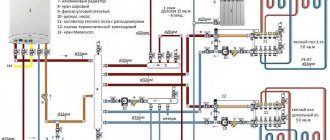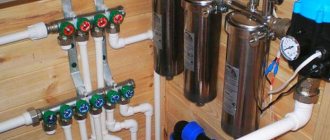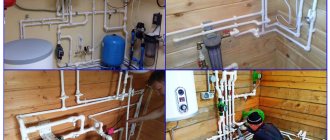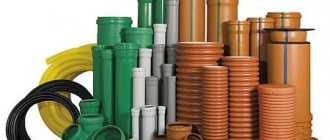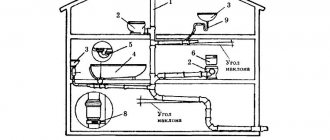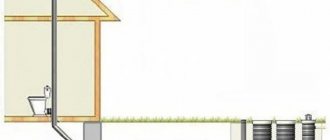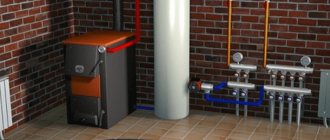A few decades ago, many residents of private houses dreamed of living in an apartment with all the amenities. Now, thanks to the introduction of new scientific and technological progress, the level of comfort in country houses is not inferior to, and in many cases even exceeds, the advantages of standard city high-rise buildings. Utilities in a country house include electricity, heating, water supply, hot water supply, and sewerage. Even if there are no centralized networks near the estate, it is possible to design and create an autonomous infrastructure of technical systems.
Types of engineering communications
If there is no main water supply, heating pipeline, sewerage system or the possibility of connecting to them near a suburban area, there is a need for individual technical networks. In modern houses, the development of all important communications is carried out already at the design stage of the cottage. If there are no errors in calculations and correct installation, engineering systems will last a long time without requiring repair or reconstruction. Each owner of a country house has his own idea of comfortable living conditions. Some are satisfied with the availability of electricity, heating appliances, a warm bathroom, and, if possible, natural gas. Connoisseurs of comfort additionally equip their homes with air conditioning and ventilation systems.
A modern country cottage usually has the following utilities:
- Water supply.
- Sewerage.
- Circuit.
- Gas pipeline.
- Ventilation.
Electricity
Lighting in private homes is provided by electricity. Electricity is supplied to the cottages via street poles from power transmission lines (PTL). Electrical cable installation work is being carried out inside the houses. Wire outlets for sockets, lamps and switches are installed in the premises.
The type of wiring depends on the wall material. In frame buildings, wiring is performed on the outer surface of the walls. In block houses, electrical wires are laid in grooves. In brick and concrete walls it is often hidden under a layer of plaster. The use of cable channels allows you to organize wiring along the outer surface of the walls.
After installing the internal wiring in the room, work is carried out to install lighting networks on the site. It is important to choose the correct insulation of electrical cables when wiring outside the house to power street lights or other lighting fixtures. Each internal and external electrical network in cottages must have protection against current and thermal overloads.
Creating an electrical wiring project is of no small importance. Only through competent design can you achieve ideal operation of the electrical network, without interruptions. Situations often arise when turning on a washing machine or kettle, the refrigerator and other powerful appliances in the house turn off, when the rooms are literally crammed with sockets and switches, but absolutely no thought has been given to installing several stationary meters to ensure an uninterrupted supply of electricity from the network.
Water supply system
If you have a centralized water supply, providing your home with clean water is not particularly difficult. If there are no water mains nearby, an autonomous water supply system is created.
Good to know: water supply for a private home from A to Z for beginners and more
To supply water from aquifers, the following is constructed:
- Well. This method of individual water supply is less complex and costly. For its construction, it is necessary that groundwater be located no deeper than 30 m from the soil surface. Concrete rings are installed in the dug hole to protect the walls from crumbling and destruction. A pump is lowered into the finished well, and the water is purified by a filter.
- Water well. It can be sandy and artesian. The first type of structure has a depth of no more than 40 m; it is arranged for irregular residence in the house. The length of the artesian well reaching the limestone aquifer is 200 m. The water contained in it is sufficient to supply water to a small settlement. To drill an artesian well, you must have a license.
It is important, even before the start of construction, to correctly design the place where pipes enter the house, the location of the premises into which water will be supplied (kitchen, bathroom, toilet, sauna), and the sewage system. This will save you from problems when using and maintaining the systems in the future. It is necessary to purchase high-quality pipes and fittings for installing a water supply system. Previously, in dachas there was no supply of hot water to the shower or kitchen; it was heated on stoves in a saucepan or bucket. Nowadays, installing a hot water supply system in a country house does not present any difficulties; it is enough to install an electric or gas water heater.
What rules must be followed when installing a sewer system?
An experienced craftsman should take four factors into account when designing and subsequently planning installation construction work:
- sewerage maintenance - with the assistance of a specialist or with your own hands;
- the number of people living in the house;
- how often will the residents of the house use the sewer system;
- location and type of septic tank or septic tank.
For houses that are not large in size and area, a sewer system with a simple layout is suitable. These projects do not cause serious financial damage, but are more effective. If the water intake points are located close to each other, then one riser can be used.
Installation of the sewerage system must be carried out by specialists and in compliance with strict technical and sanitary standards. For example, a septic tank must be located at least five meters from the house. If the distance is limited, then, unfortunately, this may lead to cracks in the future. On the contrary, if the distance is large enough, then it will be necessary to clear the pipeline of accumulated blockages.
You also cannot install a sewer system near a neighbor's fence.
Wastewater disposal
Until recently, in the absence of a centralized sewer system at a sufficiently close distance from the house, cesspools were made to drain wastewater - sealed or with absorbent walls. Nowadays, autonomous systems are being built that allow not only to drain, but also to purify wastewater. For these purposes, an individual septic tank is installed. Different models have different throughput capacities; the maximum volume of treated wastewater is 20 m3 per day. When installing a septic tank, they are guided by sanitary rules and take into account the height of the groundwater.
The most popular types of septic tanks are:
- Concrete. The system includes from 1 to 3 wells, during the passage of which dirty water is freed from large and small particles and impurities. Purified water is used to water plants.
- Biological treatment station. It is a tank with 1, 2 or 3 chambers. Plastic is usually used for manufacturing. It has significantly higher productivity and service life (up to 50 years). But the cost is also high. After purification, the water is used to irrigate green areas.
How to organize sewerage in a country house with a septic tank
If the dacha will be visited mainly on weekends, there is no point in building any complex system. The most reasonable option in this case is to install a storage tank, or make a cesspool, but it must be sealed. Since visits will be rare, cleaning will be required infrequently, and to make it needed even less often, biological products are used that accelerate the decomposition of organic matter, at the same time reducing the volume of wastewater.
Scheme of organizing an autonomous sewer system with a septic tank and a filtration field
With more active use of the dacha plot, a more serious sewage system is needed for the dacha. A smart choice is to install a septic tank, make filtration fields according to the instructions, or install an absorption well. It is better to take a factory septic tank, if possible - fiberglass. It, of course, costs quite a lot of money, but homemade septic tanks, although they are cheaper to build, require constant repairs during operation, and besides everything, most of them suffer from leaks. This is a dacha, after all, and everything that gets into the ground ends up on your table - in the form of water, if the water supply is from a well or borehole, and then in the form of the crops that you water with this water.
If you definitely decide to make a septic tank with your own hands, there are several options:
- Monolithic concrete. It is possible to achieve a high level of sealing, but the amount of work is large and requires a lot of time.
Such a septic tank at the dacha can be built from brick or concrete - Brick. Not the best option, as it can be destroyed on heaving soils. Can be used provided that the walls are plastered. Tightness can be achieved using modern waterproofing coating materials.
- Septic tank made of concrete rings. When properly executed, it works well, but can be used without problems on soils that are not prone to heaving. On clays and loams, the rings often move out of place and the tightness is broken. Repair is a complex and unpleasant undertaking.
- Made of metal. The tightness is at a high level, but until the metal corrodes, and this will happen quite soon.
The easiest way is to make a septic tank at your dacha from concrete rings. Its volume should be large enough - it is believed that such a device should have room to accumulate a three-day supply of wastewater. Consumption per day is assumed to be 200-250 liters per person, the total consumption is calculated according to the number of people in the dacha at a time, with some reserve in case of guests arriving. For a family of 3-4 people, the usual volume of a septic tank is 2.5-3 cubic meters.
Heating system
One of the most important engineering systems of a home, ensuring the possibility of comfortable living in a house during the cold season. To install heating, you need to decide on a heat source, select radiators, a boiler, and, if necessary, consider an alternative method of heating the premises.
Heat sources
The main element of the heating system is the boiler. It generates heat from gas, electricity, solid or diesel fuel. In a wooden house, special attention must be paid to fire safety measures when installing a heating system with gas or electric equipment. When choosing a boiler, the size of the country house is taken into account. For a small or irregularly used cottage, it is wiser to choose an oversized model, which, for example, can be installed even in the kitchen.
If the house has a large area, it is better to install a multi-circuit system in a specially designated room. Make a chimney and ventilation system in accordance with the operating requirements of the selected boiler model. The heated water can be used for washing dishes, laundry, heated floors, heated air in ventilation pipes, and supplied to the pool. With sufficiently high power, such equipment can provide heating for several nearby structures.
Heating devices
Heat is transferred into the rooms through warm water pipes to radiators. They are most often made from aluminum, steel, cast iron, or a combination of the two types of metal.
Alternative heating
Heated floors can be used to heat rooms. They use liquid circulating through polyethylene or metal-plastic pipes as a coolant. Most often, heated floors are used in hallways, kitchens, bathrooms and bathrooms, both in addition to radiators and as independent heating. After laying the pipes, the operation of the system is tested, a cement-sand screed is made and ceramic tiles are laid. It is recommended to use this type of heating system if reinforced concrete slabs are used to create the foundation of the house.
Use of technological innovations
When installing turnkey heating systems, you can set the automatic or semi-automatic operating mode of communications, including when using firewood to generate heat. This not only makes it easier to operate the equipment, but also saves fuel.
Calculation of the maximum hourly gas flow m3/h
To carry out the calculations, you will need to add up the power of all gas appliances and divide this number by 8.6.
The formula looks like this:
MCHRG = (Nboiler + Nstoves + Nother equipment) / 8.6.
This indicator is measured in m3/h. The boiler power is influenced by the size of the heated room (S, m2). The formula depends on the type of boiler (domestic or imported):
Notech.cat = S * k / 10 * 1.15;
Nimport.cat = S * k / 10,
where: k - power density coefficient. This indicator is measured in kW; 1.15 is an additional coefficient. It is used because the efficiency of domestically produced boilers is lower than that of foreign ones. The power of a conventional stove consisting of 4 burners and an oven is 10 kW. The power of other equipment, if any, is found in the operating instructions.
Electricity supply
During the construction of a cottage, external and internal electrical networks are laid. The complex of design and installation works includes:
- Calculation of electrical wiring parameters, taking into account the load that it will experience. This takes into account the number of connected electrical appliances.
- Assembling a power panel, laying and routing cables.
- Installation of an electric meter.
- Installation of lamps, switches and sockets.
- Laying cables for underfloor heating with electric heating.
- Installation of a generator of any type to generate and supply electricity in the absence of voltage in the general network (if necessary).
- Installation of solar panels (at the request of the customer).
How does modern gas heating equipment work?
Only by increasing efficiency can a reduction in gaseous fuel consumption be achieved. Today, to ensure comfortable conditions in the home, the most economical devices created by universal technological methods are used.
A small consumption of natural or liquefied gas is possible when using an electronic control system - controllers.
They allow you to control the supply of fuel, supplying it in the minimum required quantity for intensive combustion. Gas boilers operate in the optimal mode for them, providing the highest possible efficiency parameters. The valve controlling the supply of gas-air mass closes when the set procedure increases. The coolant circulating in the heating system is gradually cooled to the limit set by the automatic system. The valve, opening, supplies the mass into the chamber. This mixture ignites easily from a continuously operating igniter. Universal type boilers constantly operate in intermittent mode, heating the coolant quite quickly. The indicator of a heating device, which characterizes specific fuel consumption, is decisive today.
Ventilation of premises
In modern homes, systems are often found that provide fresh atmospheric air. There are 3 ways to move air flows: natural, forced ventilation and mixed, combining the first two types. According to the principle of operation, ventilation systems are divided into supply, exhaust and supply and exhaust. In country houses, the latter type of ventilation is usually used. The equipment installed for these purposes is small in size, consumes little electricity, and during operation filters the air, reducing or increasing its temperature to values that are comfortable for the consumer.
Calculation of liquefied gas consumption
Many boilers can run on liquefied gas.
How profitable is this? What will be the consumption of liquefied gas for heating? All this can also be calculated. The technique is the same: you need to know either the heat loss or the power of the boiler. Next, we convert the required quantity into liters (units of measurement of liquefied gas), and, if desired, we count the number of required cylinders. Let's look at the calculation using an example. Let the boiler power be 18 kW, respectively, the average heat demand is 9 kW/hour. When burning 1 kg of liquefied gas, we obtain 12.5 kW of heat. This means that to get 9 kW, you will need 0.72 kg (9 kW / 12.5 kW = 0.72 kg).
Next we consider:
- per day: 0.72 kg * 24 hours = 17.28 kg;
- per month 17.28 kg * 30 days = 518.4 kg.
Let's add a correction for the boiler efficiency. We need to look at each specific case, but let’s take 90%, that is, add another 10%, it turns out that the monthly consumption will be 570.24 kg.
To calculate the number of cylinders, divide this figure by 21.2 kg (this is the average kg of gas in a 50 liter cylinder).
In total, this boiler will require 27 liquefied gas cylinders. Calculate the cost yourself - prices vary in the regions. But don't forget about transportation costs. By the way, they can be reduced by making a gas holder - a sealed container for storing liquefied gas, which can be refilled once a month or less often - depending on the storage volume and demand.
Again, remember that this is just an approximate figure. In cold months, gas consumption for heating will be higher, in warm months it will be much less.
PS If it is more convenient for you to calculate the consumption in liters:
- 1 liter of liquefied gas weighs approximately 0.55 kg and, when burned, produces approximately 6500 kW of heat;
- There are about 42 liters of gas in a 50 liter cylinder.
Source: otoplenie.site
Gas supply
The most inexpensive and convenient type of fuel for heating a private home is natural gas. In addition to heating rooms, it is used for cooking and as a source of fire in fireplaces - a popular design solution for decorating halls and living rooms. Typically, pipes from a central gas pipeline are supplied to the house to supply gas. In a non-gasified settlement, a gas holder - a reservoir filled with liquefied natural gas - can be used as an alternative method.
Gasification of residential buildings is carried out by specialized companies. Work can be carried out in any season of the year. When installing an autonomous gas pipeline into a turnkey house:
- a project is created indicating the appropriate boiler model, meter name, pipe type;
- an estimate is drawn up;
- a permit for gasification of the house is obtained from the relevant organization;
- pipes are laid, a gas tank with a reducer is installed to reduce the pressure of the supplied gas;
- The system is tested and, if there are no gas leaks, it is put into operation.
Scheme of autonomous gas supply for a private house:
Why is it necessary to determine the maximum hourly gas consumption?
Among the tasks that need to be performed in order to gasify a heated building, this calculation is one of the main ones.
Its correctness is controlled in Moscow by JSC MOSGAZ, and in the Moscow region by JSC Mosoblgaz. When compiling, the magnitude of the thermal load is calculated. You also need to calculate the amount of heat that the heating system must produce and the hourly volume of gas required for this, measured in m3/hour. The consumption must correspond to the flow in the distribution main.
Using this calculation, the maximum hourly gas consumption for a private home during maximum consumption is calculated. This represents the peak fuel consumption of the facility. And then the data is compared with the capabilities of the gas pipeline.
Determining the maximum hourly gas flow rate in m3 is mandatory when preparing:
- documents for obtaining specifications for connection;
- applications for technological connection to the main line.
Forms are submitted by both individuals and legal entities when drawing up the documents necessary to gasify a private home. A sample application form and template can be found on the website.
Execution of design work
When built from scratch, a country cottage immediately contains all communications and, as a rule, is more convenient to operate compared to housing in which utility networks are installed gradually at fairly large time intervals. In a new building, all life support systems are included in the design from the beginning, which contributes to the maximum efficiency of their interaction subsequently. But this cannot be done in cases of alteration of purchased housing, gradual construction of a new one or renovation of an old house as financial opportunities arise.
When creating a project, the following are taken into account:
- the amount of funds planned to be spent on construction;
- how the house will be used - for permanent or periodic residence, the number of residents, the availability and characteristics of technical devices;
- area and number of floors of the cottage - in case of significant loads on engineering systems, equipment with greater power is selected;
- if there are no water, heat, or gas supply lines near the building, alternative, autonomously operating networks are built.
After reviewing the customer’s wishes, the following are drawn up:
- A preliminary design containing a diagram of the location of utilities.
- Technical task. It includes drawings with a detailed study of the processes for laying networks, and a preliminary estimate is indicated. When drawing up technical specifications, take into account:
- The distance from the house to the summer kitchen and other outbuildings, the place of water intake (well or well), septic tank. This data is necessary to calculate the length of external pipelines, select the location of their entry into the house and the method of installation - by air or underground.
- Volume of water consumption. The calculation takes into account the area of the house, the number of residents and the type of heating system.
- Amount of electricity consumed. When calculating, the power of household electrical appliances is summed up. This information is necessary for selecting cables, RCDs, circuit breakers, as well as the location of the distribution board.
- Distance to the nearest electric pole. If the distance from it to the house exceeds 25 m, it is necessary to install additional support or run the cable underground.
Carrying out technical communications requires significant costs; the cost of their construction sometimes amounts to 25–35% of the cost of a new country house. Therefore, you should be very careful about the selection of engineering systems and the quality of installation work, since altering or repairing them will be very expensive. The best option for laying communications is to take them into account in the construction plan when designing a cottage and follow the correct sequence of installation stages.
Design of systems: gas supply, water supply and sewerage
Good luck for the developer if there is a central water supply. After all, it will take much less effort. When developing a project, you only need to determine the best placement of pipes in the house and coordinate your plan with Vodokanal. The diagram should indicate methods for supplying both cold and hot water.
Almost every owner of a private house, with a standard approach to water supply, installs the following systems:
- pump for pumping water from a well;
- hydraulic accumulator;
- water purification unit;
- pipelines for external water supply;
- pipelines for internal water supply.
Drawing up a gas supply project for a private house goes like this:
- Specialists get acquainted with the features of a private home, calculate the annual gas use and determine the limit.
- Second step: laying gas pipes to the house. Calculation of pressure when gas enters the home.
- The project takes into account: the external connection of the house with the main line, installation of devices that regulate gas pressure, installation of filters for gas purification.
- Creating a drawing.
- Going to the gas company and concluding an agreement to connect to the main gas pipeline.
If it is not possible to connect to the main line or create a gas holder, then you will need to choose the fuel on which the heating communications in your house will operate. You can choose either a universal boiler that can “digest” any fuel, or a boiler that runs on one type of fuel. Professionals recommend installing either a liquid fuel or solid fuel boiler. In recent years, boilers that operate on solid fuel and supply hot air through a pipeline have become popular.
“Warm floors” are also used. But it is important to insulate all rooms and eliminate the slightest gaps between window openings and windows.
Good ventilation in the house means pleasant coolness in the hot season and clean air that meets hygiene requirements. The types of ventilation system can be different; their effective operation is important. And this requires the correct selection of communication equipment.
Exiting sewerage from a house with a strip foundation
Strip foundations are most often used for building houses. In this case, the base tapes are laid only under the load-bearing walls. Therefore, it is much easier to output communications here.
It is worth noting that the strip foundation can be recessed or not recessed. The first option is easier to work with, but the second is more practical.
In order to draw out the sewerage system with a non-buried strip foundation already built, it is necessary to destroy the blind area and dig a trench to the building at the required depth. Next, the required section of the subfloor is opened, and a pipeline in sleeves is laid under it.
If the foundation is deep, then it is easiest to work on the house if there is a basement. In this case, the work is carried out by analogy with the previous option. To lay communications in the foundation of a house without a basement, you can use several other methods:
- Making a hole to enter a house with diamond drilling is the least dangerous method for the foundation, which is used extremely rarely. The whole point is the high cost of such work. The cost can be reduced by renting the device and doing everything yourself.
- Some people use a hammer drill. However, this method is bad because the tool creates vibration, which can destroy the concrete from the inside. Therefore, professionals do not recommend using it.
- The non-impact drilling method is cheap and safe, but long and labor-intensive. In this case, holes are drilled around the perimeter of the desired hole. Then pieces of concrete are knocked out with a percussion tool, and metal reinforcement is cut out with wire cutters.
How to lay communications in a private house
Sewerage
If it is possible to “connect” a private building to the main sewer line, that’s great! Otherwise, you will need to think about which sewer system is best for your home. Both the biotreatment system and the septic tank have pros and cons.
Expert advice: how best to install sewerage in a private house with your own hands
A standard septic tank is a hermetically sealed container buried deep in the ground. The container is used for storing biological waste. When the container is filled, the contents are removed using a sewer truck. Pros of a septic tank: no electricity is required and there is no need for constant maintenance.
The biological treatment system ensures filtration of wastewater from 98% of harmful substances. The output is clean water suitable for watering plants. When choosing a sewerage system, they are guided by the price of equipment and maintenance.
When choosing any option, sewer pipes are laid at a constant slope. It is better to start such work when constructing the foundation of a private house, taking into account the wide diameter of the drainage pipes.
Communication pipes are installed in different ways: they are mounted in the floor screed, and if there is a basement, through the subfloor. If the house has two or three floors, then the pipes are “walled” into a ceiling box or “hidden” above the suspended ceiling of the first floor. The slope for draining and discharging waste products is solved by installing a pumping station.
The sewer pipe riser is installed on the roof. This is why it is so important to have a general design of the house to coordinate the arrangement of communication nodes. Before installing sewer lines, calculate the shortest distance between the drain system and the drain pipe. To avoid blockages, the length of the supply pipe has a cross-section of 20-25 mm. Also, the house must have a ventilation riser installed, which is installed on the roof of the house.
Water supply for a private house
In order to constantly have water in a country house, you will need a working water supply project. The scheme includes the following points:
- hydraulic design;
- instruments: sensors, pressure gauges;
- pumps;
- hydraulic accumulator;
- shut-off valves;
- pipeline;
- collectors (if needed).
Irrigation equipment, water heaters, etc. are also often purchased.
When planning water supply communications, an important point is taken into account: the level of communication connection to the water pipe must be below the freezing level of the soil. Often connected via an inexpensive “pitless adapter” device. Another option is to make a pit or use a caisson.
Important! The connection to the pipeline should be deeper than 1-1.5 meters.
If the well is a source of water, then a hole is made in its base for the pipe. When pipes are laid, it is important to seal the joint.
For a well or a well, a trench is dug from the hydraulic structure to the building. Its depth is 50 cm below the ground freezing level. At the same time, make a slope of approximately 15 cm per meter of length.
The dug trench is covered with sand. A layer of 7-10 cm is enough. The sand is moistened and compacted. Pipes are laid on top of such a cushion, their connections are made and strength tests are carried out. To check, apply pressure 1.5 times higher than the main planned indicators.
If everything is fine and there are no leaks, the trench with the laid pipes is first filled with another 10-centimeter layer of sand and lightly compacted. Then the soil is laid. With its installation, cables from the pump are carried out.
It is possible not to lay pipes below the freezing point of the soil:
- The pipes are laid at a depth of 0.6 m, and on top of 0.3 m they are “covered” with insulating material.
- Used as insulation: foam chips, coal slag, expanded clay.
- After installation, the insulation is compacted. It must be durable and not have any seals after compaction.
- They also produce special insulation for pipes.
- If a corrugated “wrap” is used, the trench depth can be 30 cm.
But in the northern regions of Russia, pipes are laid together with a special heating cable.
Inserting a pipe into a country house
Water from a well can be piped into a building directly through the foundation. But it is at the junction that the pipe often freezes due to the fact that the concrete allows moisture to pass through. Freezing is avoided if a pipe of a larger diameter than the water pipe is used for the protective “fur coat”.
The following materials are used for the protective casing: plastic, metal, asbestos. Due to the large diameter, heat-insulating material is placed between the “lower” and “upper” pipes. It is recommended to drive a rope in the middle of the pipes. Then from there to the beginning of the base - polyurethane foam.
Important! It is in the foundation that the pipe enters, but not under it. Under no circumstances should the ground under the house be touched after construction! The gap between the water supply communications and the sewage system must be at least one and a half meters!
Laying water supply pipes inside the house
It is important at the stage of bringing water into the house to decide what kind of wiring will be inside the rooms. There are closed and open internal wiring. With the open method, all pipes are visible. When closed, pipes are laid both in the walls and in the floor. Minus: if the pipes need to be repaired, you will have to remove the coverings to get to them.
Types of internal wiring:
- tee;
- collector;
- mixed.
With the collector type, a “comb” (collector) is installed, from which pipes go to all plumbing communications. The presence of a collector in the communications stabilizes the pressure of the “comb”. The downside is the high cost. A huge plus is that when one type of plumbing is being repaired, others can be used without problems at the same time.
The tee type is also called serial and all plumbing is connected in turn. The wiring is simple and cheap, but there are disadvantages: water pressure is lost in the communications. Also, during the repair of one type of plumbing, the others are also turned off.
The mixed type speaks for itself. Plumbing is connected in series, and faucets are connected through a manifold.
It is best to use polymer pipes rather than metal ones. Pros: no welding required, easy to connect.
Advice! You should use a metal pipe from the toilet.
It is also important to choose the right pipes and the option of gaskets between them. Now they produce pipes separately for hot and cold water:
- Polypropylene. Pipes made from this material are the cheapest and can be used for up to 25 years. The pipes are connected by soldering using polypropylene fittings.
- Metal-plastic. Metal-plastic pipes will last up to 50 years. Connected with metal crimp fittings. The price does not greatly exceed the first option: polypropylene pipes. But the fittings themselves are 20 times more expensive than pipes.
- Cross-linked polyethylene. Pipes made from this material have become very popular in recent years, although the cost of pipes and fittings is high. Service life – 50 years.
Which pipe option to choose depends on the installation method. If pipes are laid in a closed way, then there is no point in saving. Otherwise, you will have to make repairs to both pipes and wall or floor coverings. And when pipes are planned to be laid underground and repairs are not difficult to carry out there, then you can choose any material option.
When laying pipes, it is important to remember about their pressure testing. That is, after complete installation and connection, all pipes will need to be plugged. Then the pressure in them is increased using special equipment and functionality is checked. This check must be carried out in order to eliminate all imperfections and defects. And only after the “test drive” do they move on to the next stage of construction.
The main parameters of water supply communications taken into account at the design stage:
- The numerical value of the water pressure in the system must remain constant.
- If at first there is no required pressure at the inlet, there is only one way out - pumps are brought into operation, increasing the pressure to the required value.
- A clear balance is required: the same pressure on each wiring. During design, individual taps are added to maintain balance.
- The home's hot water supply must have recirculation.
- The use of shut-off valves will allow in the event of an emergency to disconnect only one emergency consumer.
When laying water pipes in a country house, they draw up an executive diagram. The exact lines of the pipes and their depth are noted on the drawing. In the event of an unforeseen accident, the scheme will be useful both to repairmen and to the owner of the cottage. When you need to hang a cornice and need to hammer into a wall, the drawing will make it clear where this can be done without damaging the communication pipe.
Power supply for a country house
If you independently supply electricity to a site or house, the following recommendations will come in handy. The transmission of light is divided into two stages. There is no escape from bureaucracy - this is the first stage: collecting documents from various authorities. The second stage is the electrical wiring work itself.
To obtain permission, a certain package of documents is prepared. Package includes:
- your passport, and if the application is submitted on behalf of another person, then a power of attorney will be required;
- a document confirming your ownership of real estate;
- plan diagram with the exact location of all systems on the site: water supply pipes and gas pipelines;
- The plan indicates the pole of the power line closest to the house.
If the nearest pole is located further from your property than 25 m, then a new pole must be installed on the land. Unfortunately, this pleasure often comes at a cost out of your pocket.
Based on your documents, the energy company issues technical specifications. And you can start supplying electricity to your site. Connection failure may occur for various reasons. In this article we will not consider them.
After receiving the technical specifications, everything that is specified in the document is purchased: switch, meter, etc. At your site, the box is attached either to a made support or to the wall of the house. The technical specifications contain a diagram according to which the connection can be made independently or with the help of an electrician.
The supply of electricity from the pole (either installed by you or an old one) to your territory is carried out by the company’s employees. They will install a seal on the meter and ask you to sign the connection certificate.
The above work is carried out with mandatory observance of safety precautions. Electricians must carry out the installation and installation of a protective grounding loop, since in a private house there are a lot of electrical appliances per square meter.
Gas supply to a private home is also not so simple. Bringing gas to your home takes a long time. You also need to obtain technical conditions by providing your documents. We will not describe here the ordeals of country house owners. May you be lucky and all the paperwork will end with the desired document in your hands.
Having received the technical conditions, you can begin the gasification project at home. This type of activity is carried out by companies with a certificate of the required permission to work with gas and gas equipment. You just choose one organization or another. When supplying gas to a country house, you need to be patient, as gasification takes several months.
Experts recommend installing an autonomous gas supply in a country house. It is based on the use of gas tanks, a kind of large storage facilities for blue fuel.
This is beneficial, because the gas tank ensures an uninterrupted supply of gas to the house, completely solving the problem of hot water supply and providing high-quality heating for a private home.
Also, in the event of an emergency power outage in the house, the gas generator will additionally provide light to the premises. When the gas pipeline and gas generators are installed correctly, you can also save on electricity.
Equipment for autonomous gas supply can be installed fairly quickly. The gasification technology itself is that a gas tank is buried in the area around the house. And from this reservoir a gas pipeline is laid directly to the building. Gas storage tanks come in different sizes. Depending on the size of the house, the size of the tank is also selected.
As written above, gas supply to a private home is carried out by organizations with a license for such work. Specialists carry out both the design of an autonomous gas supply and the installation of a gas tank and gas pipeline to your home.
Investments in the engineering systems of a country house can reach up to 1/3 of the total estimate for construction and installation work. Properly arranged communications can make your home comfortable and livable.
The complexity and cost of supplying gas, water, electricity, and sewerage to your home is affected by the arrangement of central communications in your area. The organization of public amenities will take place without problems if highways pass nearby. If all or one of the types of centralized communications is missing or unsuitable, then an individual option (project) is created. Its implementation depends on the wishes and availability of funds from the customer.
The expert answers: where to start renovating an old wooden house?
How to choose the correct size of pipes for water supply?
When introducing water into your home, it is important to choose the correct size of pipes used. If it is too small, several problems may arise:
- water may pass noisily through laid pipes;
- A coating forms inside the pipe, which makes it difficult for water to move through.
When choosing a pipe diameter, experts recommend relying on 2 main indicators: the speed of water movement, as well as the total length of the pipeline. The first parameter is usually standard: water moves at approximately 2 meters per second. The second largely depends on the area of the house and the distance of the plumbing equipment.
So, if the planned length of the pipeline is up to ten meters, it will be enough to use pipes with a diameter of 20mm, 10-30m - 25mm and over 30m - 32mm.
Compliance with all the rules will help you cope with introducing water into the house on your own. However, even if builders will install plumbing into your home, it would be a good idea to consult with plumbers. They will tell you how best to do this and what materials to use for this. It is important to make sewerage and water at a distance of at least half a meter. The pipes bringing water into the house should be made a little higher so that they do not flood into the screed. The sewer can be filled without problems. You may need to connect various devices to the water pipes: a storage tank or a pump. If we take into account all the nuances, then the pipeline, even organized without the involvement of a professional plumber, will last for many years.
Determination of hourly gas consumption
The estimated hourly gas consumption for technological and heating and ventilation needs of industrial enterprises should be determined as a share of annual expenses according to the formula, m3/h:
, (2.24)
where is the number of hours of maximum use for a given type of load.
The number of hours of maximum use of industrial enterprises depends on the type of production, technological process, and the ratio of technological and heating loads.
The number of hours of maximum use for industrial enterprises can be approximately taken as follows:
— for enterprises operating in 3 shifts with a continuous technological process mп.т = 6500 h/year.
— for enterprises operating in 2 shifts mп.т = 4750 h/year.
— for enterprises operating in 1 shift mп.т = 3500 h/year.
The number of hours of maximum use for heating boiler houses is determined by the formula:
, (2.25)
The estimated hourly gas consumption for standby heating is determined as part of the estimated gas consumption for heating according to the formula:
, (2.26)
where is the estimated gas consumption for heating, m3/h.
The Kd coefficient takes into account the gas consumption for heating during non-working hours to maintain the temperature and is calculated using the formula:
, (2.27)
where is the internal air temperature during working hours, take .
The results of calculating hourly gas consumption are given in Table 2.13.
Table 2.13 – Hourly gas consumption by industrial enterprises
| № | Enterprise code | Number of working hours per day | Maximum usage hours | Estimated hourly gas consumption, m3/h | Gas consumption for emergency heating, m3/h | Total hourly gas consumption, m3/h |
| mp.t | on technology | for heating | ||||
| PP-1 | 1384,62 | 4310,34 | — | 5694,96 | ||
| PP-2 | 276,32 | 785,74 | 563,38 | 1625,44 | ||
| PP-3 | 1582,42 | 4926,11 | — | 6508,53 | ||
| PP-4 | 821,2 | 1877,09 | 1345,87 | 4044,16 | ||
| PP-5 | 978,95 | 2783,76 | 1995,96 | 5758,67 | ||
| PP-6 | 577,88 | 1320,91 | 947,09 | 2845,88 | ||
| Total: | 5621,39 | 16003,95 | 4852,3 | 26477,64 |
Gas consumption mode
All urban consumers (domestic, municipal, public and industrial) consume gas unevenly. This unevenness occurs across months of the year, days of the week and hours of the day.
The unevenness of gas consumption is determined by the lifestyle of the population, the operating mode of enterprises, institutions and medical institutions, climatic conditions, and depends on the characteristics and number of gas consuming installations.
Uneven gas consumption negatively affects the functioning of gas transmission systems. To smooth out uneven gas consumption, various methods are adopted, the essence of which boils down to the following:
— alignment of gas consumption schedules;
— covering peak loads from other sources.
Both of these methods lead to higher prices for gas transportation and sales and reduce the economic performance of gas supply systems.
Warm floor or conventional radiators
Also, the correct heating design plays an important role. It is estimated that a well-designed and implemented heated floor will reduce gas consumption. Conventional radiators would require more gas to heat indoor air to the same level. This is due to the fact that thanks to a warm floor, heat rises from bottom to top and spreads throughout the entire area of the room. But conventional batteries heat the outer wall, which is why their efficiency is lower.
Also, the standard floor temperature is 50 degrees, the radiator is 90 degrees. Obviously, the floors will be more efficient and economical. Yes, the project and installation of flooring will cost more, but the difference in price will pay off very quickly.



